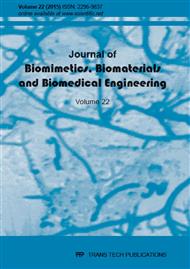[1]
Marjan Bahrami Nasab and Mohd Roshdi Hassan. Metallic Biomaterials of Knee and Hip - A review. Trends Biomater. Artif. Organs, Vol 24(1), (2010), pp.69-82.
Google Scholar
[2]
H. Dong and T. Bell. Enhanced wear resistance of titanium surfaces by a new thermal oxidation treatment. Wear 238 (2000), p.131–137.
DOI: 10.1016/s0043-1648(99)00359-2
Google Scholar
[3]
A. Bloyce, P.Y. Qi, H. Dong and T. Bell. Surface modification of titanium alloys for combined improvements in corrosion and wear resistance. Surf Coat Technol 107 (1998), p.125–132.
DOI: 10.1016/s0257-8972(98)00580-5
Google Scholar
[4]
David Bombac, Miha Brojan, Matija Krkovic, Radomir Turk and Anton Zalar. Characterization of titanium and stainless steel medical implants surfaces. RMZ – Materials and Geoenvironment, Vol. 54, No. 2, (2007), pp.151-164.
Google Scholar
[5]
Joe Hiemenz. Electron Beam Melting. Advanced Materials & Processes, March (2007).
Google Scholar
[6]
Rapid Protyping - Principles and Applications. Chua C. K, Leong K. F and Lim C. S.
Google Scholar
[7]
Mari Koike, Kelly Martinez, Lilly Guo, Gilbert Chahine, Radovan Kovacevic and Toru Okabe. Evaluation of titanium alloy fabricated using electron beam melting system for dental applications. Journal of Materials Processing Technology (2011).
DOI: 10.1016/j.jmatprotec.2011.03.013
Google Scholar
[8]
B. Vayre, F. Vignat and F. Villeneuve. Identification on some design key parameters for additive manufacturing: application on Electron Beam Melting. Procedia CIRP 7 ( 2013 ) 264 – 269.
DOI: 10.1016/j.procir.2013.05.045
Google Scholar
[9]
Timothy J. Horna, ∗, Ola L.A. Harryssona, Denis J. Marcellin-Littleb, Harvey A. Westa,B. Duncan X. Lascellesb, Ronald Aman. Flexural properties of Ti6Al4V rhombic dodecahedron open cellularstructures fabricated with electron beam melting. Additive Manufacturing 1–4 (2014).
DOI: 10.1016/j.addma.2014.05.001
Google Scholar
[10]
Lawrence E. Murr, Edwin Martinez, Xuemin Pan, Chuanmin Meng, Jialin Yang, Shujun Li, Fei Yang, Qinsi Xu, Jennifer Hernandez, Wenjun Zhu, Sara M. Gaytan, Frank Medina, Ryan B. Wicker. Microstructures and properties of solid and reticulated mesh components of pure iron fabricated by electron beam melting. Journal of materials research and technology. 2013; 2(4): 376–385.
DOI: 10.1016/j.jmrt.2013.10.002
Google Scholar
[11]
A.A. Antonysamy, J. Meyer and P.B. Prangnell. Effect of build geometry on the β-grain structure and texture in additive manufacture of Ti-6Al-4V by selective electron beam melting. Materials Characterization, 84 (2013), 153 – 168.
DOI: 10.1016/j.matchar.2013.07.012
Google Scholar
[12]
Geetha Manivasagam, Durgalakshmi Dhinasekaran and Asokamani Rajamanickam. Biomedical Implants: Corrosion and its Prevention - A Review. Open Access, Recent Patents on Corrosion Science, Volume 2, (2010), pp.40-54.
DOI: 10.2174/1877610801002010040
Google Scholar
[13]
F. Yildiz, A.F. Yetim, A. Alsaran, and I. Efeoglu. Wear and corrosion behaviour of various surface treated medical grade titanium alloy in bio simulated environment. Elsevier, Wear 267 (2009), p.695–701.
DOI: 10.1016/j.wear.2009.01.056
Google Scholar
[14]
S.L. de Assis, S. Wolynec, and I. Costa. Electrochimica Acta 35 (2005), pp.28-36.
Google Scholar
[15]
L.E. Murr, S.M. Gaytan, A. Ceylan, E. Martinez, J.L. Martinez, D.H. Hernandez, B.I. Machado, D.A. Ramirez, F. Medina, S. Collins and R.B. Wicker. Characterization of titanium aluminide alloy components fabricated by additive manufacturing using electron beam melting. Acta Materialia 58 (2010).
DOI: 10.1016/j.actamat.2009.11.032
Google Scholar
[16]
Hamid Reza Asgari Bidhendi and Majid Pouranvari. Corrosion study of metallic biomaterials in simulated body fluid. AMES, UDC: 669. 295. 5'71'292. 018. 8.
DOI: 10.30544/384
Google Scholar
[17]
Y. Santana Jiménez, M. Tejera Gil, M. Torrado Guerra, L.S. Baltes and J.C. Mirza Rosca. Interpretation of open circuit Potential of two titanium alloys for a long time immersion in physiological fluid. Bulletin of the Transilvania University of Brasov Vol. 2 (51) -2009 Series I.
Google Scholar
[18]
Standard practice for calculation of corrosion rates and related information from electrochemical measurments. ASTM Designation: G 102-89 (reapproved 1999).
Google Scholar
[19]
A. Safdar, L.Y. Wei, A. Snis and Z. Lai. Evaluation of microstructural development in electron beam melted Ti-6Al-4V. Material Characterization, Vol. 65, Mar (2012), pp.8-15.
DOI: 10.1016/j.matchar.2011.12.008
Google Scholar
[20]
S. Malinov, W. Sha, Z. Guo, C.C. Tang and A.E. Long. Synchrotron X-ray diffraction study of the phase transformations in titanium alloys. Materials Characterization 48 (2002), p.279– 295.
DOI: 10.1016/s1044-5803(02)00286-3
Google Scholar
[21]
Callister's Material Science and Engineering. Adapted by R. Balasubramaniam, Pg. 329.
Google Scholar
[22]
Robert Pederson. Microstructure and Phase Transformation of Ti-6al-4V. ISSN: 1402- 1757, (2002).
Google Scholar
[23]
Handbook of materials for product design. Charles A. Harper.
Google Scholar
[24]
Brendon Stuart Bass. Validating the Arcam EBM Process as an Alternative Fabrication Method for Titanium-6Al-4V Alloys. 2007 Thesis, North Carolina State University.
Google Scholar
[25]
Principles of material science and engineering. W.F. Smith. McGraw Hill Publication (1990).
Google Scholar
[26]
Linez-Bataillon P, Monchau F, Bigerelle M, and Hildebrand HF. In vitro MC3T3 osteoblast adhesion with respect to surface roughness of Ti6Al4V substrates. Biomol Eng. Aug (2002); 19 (2-6 ): 133-41.
DOI: 10.1016/s1389-0344(02)00024-2
Google Scholar
[27]
Rabab M. Abou Shahba, Waffa A. Ghannem, Azza El-Sayed El-Shenawy, Amal S. I. Ahmed and Safaa M. Tantawy. Corrosion and Inhibition of Ti-6Al-4V Alloy in NaCl Solution. International Journal of Electrochemical Science 6 (2011), pp.5499-5509.
DOI: 10.1016/s1452-3981(23)18423-9
Google Scholar


